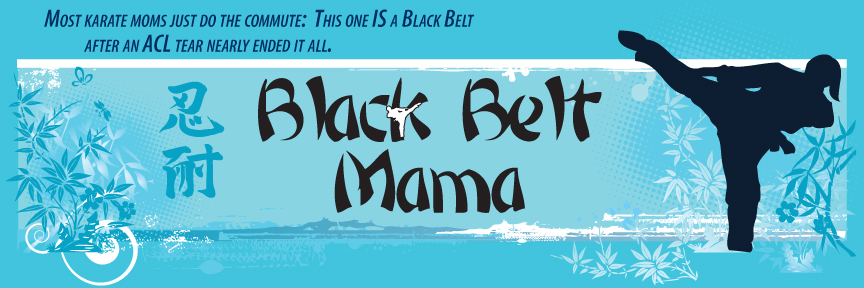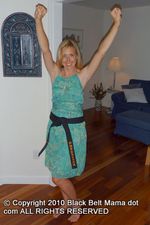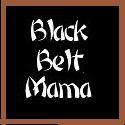Official Observer (But Not for Long)
This past weekend was the summer annual IKKF training camp. Last year, I got exactly one session in before landing on my head and being declared unable to go on by an urgent care physician. Whiplash was the diagnosis. This year, I managed to remain injury free, probably because I was relegated to the sidelines, acting instead as an observer/camp photographer at the request of the head of the organization and dojo. Because of the photographer role, I spent the weekend being the recipient of some serious scowling. Surprising, because what person doesn’t want to be photographed after sweating for six hours straight, two days in a row?
If there’s one thing this weekend taught me though, is that things happen for a reason.
I’ve attended three previous training camps. I would be lying if I told you I didn’t feel completely awkward and out of place at each and every one of them. The high ranking individuals all know each other well after training together for decades. Being there as a green or brown belt certainly gets you points for trying; but there is nothing like being in a room full of black belts to give you a major dose of "I seriously suck" reality.
I felt completely intimidated, unworthy and pathetic when I went to other training camps. Despite my role on the sidelines this time, I felt completely different. When you’re there on injured reserve, you get to quietly observe from the sidelines, but you also get to interact with high ranking individuals who have much to teach you even from the sidelines. I had some wonderful conversations with people I was previously too intimidated by to do more than smile, nod and run.
I learned that despite their high ranks, they’re normal people, fun people with much to offer someone trying to learn the art (and psych herself back up to get back at it again). I received much encouragement from people who have gone the ACL route before me. I learned a lot just by watching and being in the environment with so many interesting people.
Perhaps most importantly though, is that I now feel so much more comfortable around these people. Before they were the Renshi-Kai (and the other high ranking individuals from different styles like Kyoshi Hayes who come to our camps), the people who decided if you’d get your black belt or not. They were the ones who sit in the front when you test, with serious expressions and a clipboard, later deciding if all your hard work has paid off or not.
Now, I know that they are interesting and knowledgeable people who have much to offer. . . if only you’ll stick around for longer than a nervous smile before running away.
Before I tore my ACL, I was preparing for Shodan testing. I was feeling more and more confident about my kata and bunkai. I was gaining confidence overall. I wonder now if this injury happened when it did, only months before I was hoping to test, so that I’d have this time to get mentally ready and to interact with the people who previously would have made my knees shake. The biggest obstacle to getting that Shodan right now is me and the confidence (or lack thereof) that I have with regards to my knee.
On Saturday night at our annual banquet, I watched two individuals receive awards for fighting through the toughest of times. One is from our dojo, a new green belt who has barely missed a class despite going through abdominal surgery and subsequent chemotherapy. The other, a newly promoted 4th degree black belt who was amazing at his testing the previous night. You would never know it, but he has fought cancer and beat it four times. Both of these men have the attitude of champions, and it was emotionally overwhelming to watch them receive their awards. It was also inspiring.
I realized this weekend that it is important for me to get back to karate. This weekend ignited the fire I needed to get me back in the dojo. I really want this now. I’m going to work hard this month to build more strength in my leg in preparation for a fall return. This time, it’s not just a desire. I came home from camp yesterday and rode my bike for a while, even taking some gradual hills to help work on my leg strength. Today, my knee feels good despite the workout.
This is the beginning of my return. I am coming back.
Back on the Floor
I drove Big I to karate tonight and I couldn’t help but think that in just a few weeks, I could be training again. I was daydreaming about what it will feel like to tell everyone "I’m back!" I have not set foot on the training floor since my injury in October. It’s been a really long time.
As I entered the dojo tonight, my teacher commented about how well I was walking around. I told him that I’m getting there and hoping to return (slowly) in June. Somehow the conversation turned to Sanchin. I said I didn’t know it and he said he would teach me. I thought it would be from the sidelines.
I was having a conversation with another Mom in the dojo when Hanshi summoned me from the upstairs training floor. He told me take my shoes off and come out on the floor. I took my shoes off, threw my jacket and purse on the bench and walked out. It felt really strange being back on the floor, but even more so in jeans.
Hanshi explained Sanchin and talked about the meaning of the number "three" within our system and how it relates to pretty much everything in our style. And then we started. In a casual stance, I stood there and worked on Sanchin breathing. Then we added hand motions. When it was time to get into the Sanchin stance, I just kept my feet facing forward and didn’t worry about my stance. I spent about 40 minutes out on the floor walking through Sanchin with the rest of the class, careful not to pivot on my knee or do anything that would cause a problem.
I wanted to be completely immersed in learning Sanchin but I couldn’t help but think about my knee almost constantly. I tried to get into a good nai hanchi stance but it was really difficult to do. Like squats, I continue to put more weight on my right leg, not yet trusting my left knee to keep up with the right. I knew I was going to need some work on basics again but I had no idea how much.
I also tried to stand in cat stance with my weight on my left leg and that was nearly impossible and painful. My knee cap area just started to ache and I backed off. At one point while standing there, I started to think about how good it felt to be back out there again; but then I almost welled up with tears thinking about how difficult a journey it’s going to be to get back to where I used to be.
The reality that it is going to take me months just to get my body to do the basic things that it used to do without thinking is hitting me hard tonight. After knocking out all the things I couldn’t do at home, like carrying Lil C up and down the stairs and even something so simple as alternating steps when going up and down, I mistakenly believed I was almost there.
Going back to karate is going to pose an entirely different set of challenges. Tomorrow, when I go to PT, I’m going to talk to my physical therapist about the stances I’ll need to use and ask him to help me get there. I realized tonight that the mental aspect of coming back is going to be the hardest part, but the physical part isn’t going to be a cake walk either.
Where is my Mind? What am I Thinking? I Can’t Do This!
Filed under: Admired Martial Artists Month, Guest Post, Tales from the dojo
When I was asked to be a feature Martial Artist of the month, I thought, ohh boy…what am I going to write about? My experiences with transmitting information during class have gotten me some blank stares, sleepy eyes, yawns, and inquisitive faces…but most of all, a sense that I pulled the rug out from under their feet.
So I pondered the question and looked for something common that all martial artists go through in the beginning and while advancing through the ranks, even well into the Black belt Dan’s, so maybe I can provide a little enlightenment and not try to bore you with too much Japanese Terminology by doing it.
* * *
The class is milling about, the most Senior Black Belt or Sensei barks out the command " Narande" (line up) after Reishiki (Rei in and respects). The Sensei then tells the students what he is going to instruct in class that night, and the faces of students turn into that deep troubled look, like they left the stopper in the bathtub and forgot to turn off the water!
Whether it is Kata, Waza, Self Defense, or Weapons there is someone that is not going to like what’s in store for them that night. Mostly it is not that they dislike the techniques, it is that they have a difficult time executing what the Sensei wants them to do. So many times I hear, I can’t do this, I don’t how to move, I can’t seem to get any power, this manipulation escapes me, what am I suppose to be feeling, what should I look at, how should I react or act?
Lets look at one activity that makes many students cringe – Sparring. When Sensei barks out "pad up, Kumite," that demon opens the door and some cringe and mutter "oh no, not that," and some even start to make themselves ill, for they will have to deal with that one person or fear or the fact that they’re just not any good at sparring.
* * *
Mushin (no mind), Zanshin (alertive mind, or Warrior Spirit) – these are the building essentials that will help you break through fear and mold you on your path in Martial Arts. Mr. Apsokardu had touched on them and defined them in his article "Where Will We Take the Martial Arts". But what is the foremost needed building essential and answer to that Demon that haunts most students in their progress of learning is: Kanjo! (Emotion).
Kanjo is a leading factor in why students fail to make progress. As soon as the student finds out what he or she is going to do, his mind starts a whirlwind and goes into a spin with all kinds of extraneous thoughts of doubt, anxiety, fear, nervousness, and depression. The battle of Emotion taking place in the Mind has already been lost and there is no room for making the correct, decisive, spontaneous movements.
* * *
If you never had the fortunate pleasure to be an uke or attend a class of Hanshi Bruce Heilman 9th Dan Okinawa Kenpo Karate and Kobudo and Kyoshi William Hayes 7th Dan Shorin Ryu and Shobayashi Ryu karate at one of their seminars, I ask you to do so. There is not a better way to get the feeling of proper execution of emotion and technique than to feel it first hand. First you should know, that you are not going to get hurt. Next execute the attack they tell you to with proper speed and focused technique and leave your senses open to what’s going on. You will notice that both of these men are always smiling and humble in their way, and both have an excellent extensive background in the Martial Arts. Their stories of their experiences and of their teachers are an excellent learning experience in itself.
Now to continue on, the second you start to move, and as the attack is launched you will notice that their head tilts slightly with the chin getting near the chest to protect the neck. The grin is gone now, and their face turns to a stone like feature, the eyes narrow and the pupils dilate big and black that take up all the color in the iris, it’s like looking into the eyes of a Tiger or Shark, black and void of any emotion. One’s feeling seems to be that you just became the prey. As the attack resumes their hands move in a blur and part or parry and slice into the attack with the precision of a surgeon’s scalpel. Their grip becomes vise like and your nerves and muscles seem to tingle and spasm. Their motion and power of the counter technique moves through you like a thunderous freight train passing full speed at railway crossing. As you try to come to wits from the floor, a little disheveled but unhurt (this has all taken place in seconds), you try and compose what just happened! But as you’re helped up by them, you will notice that grin has returned again.
What you just witnessed was Kihaku (Intensity). It is a release of several mental factors such as self confidence and determination; a power focused not from sheer muscle strength, but using the subtleties of technique, in a dominating unrestrained fighting spirit that is an all out commitment, without the slightest hesitation to react naturally and an instinctive fluidity guided by the years of their training.
* * *
Anko Itosu (1830 – 1915) Shorin Ryu Karate was quoted as saying: " During practice, you should imagine yourself on the battlefield. When blocking and striking make the eyes glare, drop the shoulders and harden the body. Now block the enemy’s punch and strike! Always practice with this spirit, so when you are on the real battlefield you will be naturally prepared."
Control of emotion is not easy. It takes one step at a time. In the case of kumite, you will have to resist playing the game of tag and resolve the ego from trying to win or beat your opponent in a competitive sport type environment. Concentration, focus, pinpoint accuracy to the target, that would in reality end the confrontation. This takes time and hard work to control the ego from just winning a game. The other area’s in your style, kata, weapons ,waza, self defense are just as important of a starting area and have to work with and around each other. Lets look at some steps to start to control your emotion.
Kihon – ( Basics) Yes, I know everyone knows basics, but there’s no better place to start! But try now to start again this time with just the simple punch.
It is said, "A Single Strike Decides the Outcome of a Battle."
1st, Kokyu – (Breath) breathe & exhale; relax and settle into your kamae (stance or posture).
Breathing serves to cleanse the body. Exhale out the negative thoughts of fear, worry, doubt ,indecisiveness, hatred; they are self destructive. Inhale positive thoughts of fresh air, confidence, faith, courage, bravery.
2nd Thought – empty the mind of extra thoughts that are not relevant to the task at hand by narrowing the eyes, not in a sleepy manor, but in a gaze that seems to burn out from the eyes toward the target.
3rd Intent – having the mind focus on its purpose, its commitment to complete the technique, no matter what the outcome, or what the other person does.
4th Bear Down Fear – it’s ok to have some fear, but try to harness this emotion to power – not power into the technique, but power projected toward the opponent or target through your motion. There is a saying from one of Japan’s great sword masters Yamoka Tesshu, "Don’t try to save your ass, dash head long into the battle, true spirit will always prevail!"
5th Confidence – be confident of your skills, they do work; all your training has amounted to more than the ordinary person can perceive. Kumite, fighting in class is very difficult. Everyone has roughly the same amount of skill and technique…after a while you start to rely on tricks just to suffice the ego. This is not true Budo, this is not the True Warrior Spirit. There is a saying from an old sword school Shinto Munenryu – "The Sword Follows The Hand, The Hand Follows The Spirit."
The last is Faith – Faith that in time, with diligent practice and your Sensei’s guidance he will set you on the right path and teach you, when you’re ready, the different levels of thought, power, technique, attitude, control, perseverance.
As a final thought, I would like to borrow something from another master of the Martial Arts. Have you ever heard the statement, " Karate, is a Way of Life! " by Gichin Funikoshi? Well what better way to get through life and ensure a good lifestyle other than to control one’s Kanjo (Emotions)!
Sayonara
Z san
***Last chance. Comments on these posts will remain open until the end of the week. Leave a comment here or at The BBM Review for your chance to win a martial arts book or DVD from Turtle Press.
Our Two “Moms”
Filed under: Admired Martial Artists Month, Guest Post, Tales from the dojo
By William R. Hayes, Maj., USMC (Ret.)
“Old Student” of Shorin-ryu Karate-do
This is not a piece written with regard to a social dilemma faced by some. Rather, this is an article designed to touch upon a very real challenge experienced by more and more students of traditional martial culture – especially those who have spent considerable time in their training halls.
At the outset – for the sake of clarity – let me define the “TWO ‘MOMS’” mentioned in the title. “MOM #1” – the first (and sometimes only) “MOM” we meet in the dojo, stands for “Mastery Of Motion” and encourages the development of what might be called “Martial Science”. As for “MOM #2” – well, that “MOM” stands for “Meaning Of Motion” – and is seen less and less in dojos these days even though the presence of “MOM #2” can provide the effective “Martial Arts” we seek in the first place.
For the sake of discussion, let’s say a prospective student drops by a dojo and observes a class before seeking admission or being asked to enroll. What that person gets to see may well be martial arts displayed by experienced practitioners, however, what he or she undoubtedly gets to do, for at least the first several years of training, will be something completely different – martial science.
Let me start with the first MOM – Mastery Of Motion – “martial science”. That term includes what we are told to do and what we actually perform in a dojo over an extended length of time (sadly, in some cases, for the entire length of time we study a particular ryu-ha). “Martial science” involves stretching, calisthenics, breathing, stance work, striking, kicking, “blocking”, drills, kata, fixed bunkai, kumite, and other assorted methods and routines designed to bring us to the point where we are judged worthy of moving up in a system’s hierarchy. In other words, “martial science” training primarily describes and involves body mechanics – the kinesiology we undertake during our studies.
During “martial science” training we are exhorted to “polish” our movements for the sake of precision, snap, power, martial spirit development, style, competition, tradition, and so forth. Operating within and exemplifying that model is fine as long as we are, at some point, introduced to the other MOM – MOM #2 (Meaning Of Motion). MOM #2 is quite a bit older than MOM #1, and is a bit more complex and difficult to come to know, however, MOM #2 is truly worth meeting. If the meeting is delayed too long due to a comfort zone-created fascination with MOM #1, a misunderstanding of the original intent of the art – or – worse yet – never takes place at all due to either the limitations of the instructor, the style, or the organization propagating the style, then the practitioner may never reach full potential – and, perhaps more importantly, may not possess true self-defense or Life Protection skills should that never-hoped-for “moment of truth” ever arrive.
MOM #2 (Meaning Of Motion) is the comprehensive enabling factor which gives vitality and utility to MOM #1. When utilized in conjunction with a system’s concepts and principles MOM #2 leverages our basics, our kata, and even the seemingly street-impractical analysis (bunkai and yakusoku) we are taught during the various martial science stages of our training. MOM #2 moves us from the study of “martial science”, where the goal is to become “Brilliant At The Basics”, to an understanding of the processes that comprise “martial arts”, where the dedicated develop Intuitive Competence; where rational creativity is fully unleashed; where practitioners are not separate from their martial culture; where they master themselves, their opponents, “the moment”, and their arts through the unified, simultaneous acts of understanding and doing.
The transition from “martial science” to “martial arts” begins with ones mindset – how one is “fed” and “sees” ones art and its many component parts. Take the fundamental “middle block” learned early on during “martial science” training. “Martial science” training leads us to believe that the end of that motion (the fully formed “block”) expresses the full function of that motion. We “perfect” the “blocking” motion with repetitive drills which allow us to know ahead of time that a particular punch is on its way and that we must block it (and possibly counter it in some way). Partners eventually gain the ability to do all of that by employing well-timed choreography and safe stances, making it almost impossible to injure one another in the process. With “martial arts” we learn that a great deal more is going on when it comes to the movements involved in the “middle block” beginning with the fact that the timing and functions of the motions involved are not what they seem to be at all.
With “martial science” the object of the “middle block” is to indeed block the opponent’s punching arm in such a manner as to keep it from striking you – for many this exercise then becomes a well-oiled speed drill on the part of the “blocker” wherein mere anticipation arises as the hallmark of “successful” blocking. With enough anticipation and a slightly cooperative training partner some build great confidence in their supposed ability to “block” an attacker’s punch. Such drills can evolve to the point where the “blocking” arm is in action before the cue (the moving punching arm), is given (we’ve all seen it happen and perhaps done it ourselves). That’s a sure way to build great false confidence in our budding abilities, especially when we keep in mind that, by it’s very nature, a reaction cannot occur before an action takes place. Allowing just such a contradiction to not only occur but embed itself in our training as a “fundamental skill” is one of the ways in which “martial science” moves us further and further away from the real world of Life Protection (but closer and closer to MOM #1).
MOM #2, on the other hand, takes a different view of and approach to the notions of “timing”, “attacking hands”, “middle blocks”, and so on. Using “martial arts” perspectives/mindsets/training we learn to “cover and change body” (protecting and altering the angle of our body) in such a manner as to make a “block” both inefficient and unnecessary. With the MOM#2 approach one varies: heights, distances, angles, stances, and timing, (the five fundamental elements of movement) so as to place the defender’s body in the least vulnerable position while exposing kyusho mato (vital points) on the attacker’s body. With “martial arts” we learn to respond instantly to the psychological, physiological, and physical cues the attacker gives us prior to or just as their attack gets under way, allowing us a bit more time to reposition ourselves, redirect (not block) the attacking hand with our “front side motion” (the other hand usually not very involved in blocking drills), and counterstrike or manipulate a joint with the “back side motion” (what would have been the blocking hand in the “martial science” model) to a meridian, nerve plexus, ligament, or other target – all done near simultaneously, thereby overwhelming the opponent’s ability to deal with the situation he or she created by attacking in the first place. The Okinawa Ko Hoshin (Old Okinawan Principle) of Ti Chi Ki (What the Hand is Doing) is what is employed here by the Life Protection practitioner and it amounts to a decision cycle akin to the “O.O.D.A. Loop” (Observation, Orientation, Decision, Action) made famous by a now deceased U. S. Air Force fighter pilot named John Boyd.
A great deal changes when we get to know both of our “MOMS” – especially MOM #2. On the way to practicing and applying the processes which constitute MOM #2 we may be beset by periods of confusion – sticking points in our training during which we get to “rewire” our brains. Okinawan masters remind us that such confusion is intentional – it is part of the way ahead. For instance, take a moment to consider the habit of breathing in on a “block”. With a martial arts Life Protection mindset in operation one might breath out on that same movement since it may now be a strike and not a “block”.
Meeting, training, understanding, and integrating MOM #2 can be a martial culture-altering experience which brings us to understand why the Uchinajin no Bushi – the great warriors of the Ryukyu Islands – took extraordinary care and invested extensive amounts of time in an effort to develop and gift us with what is now our heritage.
Lastly, understanding the differences as well as the links between “martial science” and “martial arts” can allow practitioners to make personal sense of the last two lines from Robert Frost’s wonderful poem, “The Road Not Taken” – –
I took the one less traveled by,
And that has made all the difference.
With high regard for your many achievements,
Bill Hayes
Bill Hayes has written an award-winning book titled, “My Journey With the Grandmaster”; publishes a quarterly martial culture newsletter; is a “warrior wellness” product consultant; and conducts seminars in the U. S. and Europe. You can contact him regarding any of the above by writing to him at: 1105 Walker Drive, Fredericksburg, Virginia, 22401-2625; or by e-mailing him at: oldstudent1 at cox dot net.
***This is the final week to enter The BBM Review contest to win exciting books and DVDs from Turtle Press. Please visit The BBM Review and leave a comment on any post in the month of March for your chance to win! One of the giveaway books has just been reviewed! Don’t miss it!
Why Your Child is Not a Black Belt
Filed under: Admired Martial Artists Month, Guest Post, Tales from the dojo
By: Ann-Marie K. Heilman, Kyoshi
Okinawa Kenpo Karate Kobudo
Heilman Karate Academy, Inc.
To the uninformed person on the street or perhaps the new student in the dojo, all black belts may seem alike. The parent of a child whose classmate at school is an 8-year-old third degree black belt may have the feeling, “What is holding up my child’s progress?” Are all schools alike? Is there one course of study that, when followed will end with the coveted “black belt?” Or is one school easier than another? Is one school really that different from another? The answer to a traditionalist is a resounding YES! We need to do some fact finding.
In the Okinawan/Japanese systems, wearing a black belt is a sign of maturity; in other words, the student has demonstrated mature physical growth, knowledge of the physical basics of their system, has demonstrated over time an ability to make sound judgments thus revealing mental maturity. None of this is accomplished very quickly even if the student is an adult.
When we discuss techniques in class we judge a student’s ability and knowledge and expertise of technique compared to an attacker. In adults, body size usually does not change drastically. With children’s growing bodies techniques must change as their bodies change; their arm and leg length for example, as well as their height, will render some techniques useless or perhaps better depending upon their current physical size. This generally is not true for adults who reach their maximum growth by the late teens and will stay there for years.
When we consider adult versus child judgment or mental maturity we find a difference. Why consider sound judgment as a marker of black belt eligibility? Think about self-control or quick judgment in a street situation. There are adults who should not study martial arts. They haven’t learned self-control. They lose their temper, use martial arts as a "power game" over others or do not use good judgment in everyday matters. Certainly martial arts can provide them with an opportunity to learn these virtues but that depends on the quality of instruction, which is factor of the school they attend. And all schools are not alike.
In terms of the definition of a "black belt" there are many different ideas. Some systems promote individuals who are good athletes and can kick high, punch hard, and/or win trophies. There is nothing wrong with this idea, but a traditional view of the rank implies mental maturity. This does not come early in a person’s life but develops slowly over time.
We know of many kids who are excellent in the physical aspects of their art and we might call them "junior black belts” to recognize their proficiency, but they are still children. Can they teach? Sometimes. I have known a few children who can convey information better than some adults. Can they make sound judgments about people? Sometimes. But not always. That takes experience and maturity. Should we "hold them back" until they are 16? Usually, but not always. At many traditional dojos those individuals who demonstrate ability can be recognized by awarding them a junior black belt. However, full ranking is generally held off until maturity has been demonstrated and that does not come easily or quickly.
Curriculum is another matter. As a traditional dojo, the HKA offers a full program of okinawan karate and Kobudo (weapons). From basics (stances, kicks, blocks, strikes), through self-defense, sparring, to participating in demonstrations, tournaments, and dojo events – we cover a lot of material.
Sport karate is a new development that came into existence in America in the "60’s. It has blossomed and grown into a billion dollar business. It is a lot of fun and those who have accumulated a number of trophies will tell you the great feeling of accomplishment they have when they win. But sport karate is different from traditional karate where "points" don’t matter; your performance and development as a person in mind, body, and spirit does. There is much more to say on this matter and we will continue the discussion in future blogs.

























